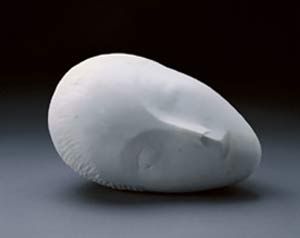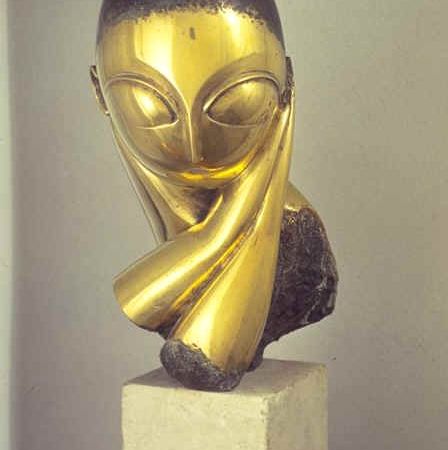Brancusi was born in a Romanian village and attended the Fine Arts Academy in Bucharest. In 1904, he moved to Paris where in 1908; he met Matisse and Modigliani and soon became one of the central figures of the modern movement. From 1913, Brancusi had an international reputation, and his work had entered major art collections in United States.
From 1908, with the first version of The Kiss, Brancusi's work became increasingly abstract. While never rejecting the natural world, he reduced the elements of an image to what he considered the bare essentials. Primarily a carver, Brancusi worked in plaster, marble and wood. He cast bronzes from the plasters and marbles and worked these surfaces to a very high polish. The works in wood were deliberately rough-hewn.

By the 1930's, Brancusi had completed all his major themes and his last years were spent making bases for his sculptures, and working on a number of large installations, one in Romania and an unrealized temple in India. Bored with Bucharest, Brancusi traveled to Munich in 1903, and from there to Paris.
In Paris, he found a community of artists and intellectuals brimming with new ideas and welcoming him into their circle. After spending two years in the workshop of Antonin Merci, another academician, Constantin was invited to enter the workshop of Auguste Rodin. This was a tremendous privilege, especially since Brancusi had long admired the eminent French sculptor and was greatly influenced by his work. But, always independent, Brancusi left Rodin's side after only two months, saying: "Nothing can grow under big trees."
It was after this break with Rodin's school that Brancusi struck out on his own, developing a revolutionary style and establishing himself as one of the leaders of modernism in art. His first mature work, entitled The Prayer was commissioned as part of a gravestone memorial. A rough, minimalist, almost primitive bronze sculpture of a young woman crossing herself as she kneels, it marked sculpture's first step toward semi-abstract, non-literal representation, and reflected Brancusi's belief in depicting not the outer form but the idea, the essence of things.
Previously, like Rodin and his followers, Brancusi had modeled his sculptures in clay or plaster and then made bronze casts. Now, he returned to the technique that was truly his own - carving. After 1908, he abandoned modeling altogether and carved all his works from wood, marble, or stone.

In the next several years, Brancusi worked on many versions of Sleeping Muse and The Kiss In these sculptures he fused the traditions of Classical, folk Romanian, African, Egyptian, and Cycladic art, as he would continue to do in all his subsequent works. Like many artists, he also began to incorporate "industrial chic" into his sculpture. All these influences helped him develop the geometrically regular and spare outlines that became the hallmark of his style. Yet, contrary to popular belief, Brancusi never became an abstractionist: though his forms became more and more simplified with time, they continued to resemble the subjects they represented.
His works brought Brancusi growing popularity in France, Romania, and the United States. Wealthy collectors, most notably the lawyer John Quinn, were buying his sculptures. Magazines and art reviews published praiseful articles. In 1913, he was simultaneously exhibiting in the Salon des Independants in Paris and at the Armory Show in New York. In 1916, Brancusi moved into a studio in the Impasse Ronsin, where he would live and work for the rest of his life.

In the meantime, he had become close with many of the intellectuals and artists who lived in Paris before and during World War I. The poet Ezra Pound and author Henri Pierre Roch acted as his confidants, spokesmen, and biographers throughout his life. For a time, Brancusi worked closely with the Italian artist Amedeo Modigliani; poet Guillaume Apollinaire and artists Pablo Picasso, Henri Rousseau, and Fernand Lger were among his other associates.
Though charming and gregarious, Brancusi was a complex and somewhat mysterious person whom few seem to have known well. Short and lively, he wore a longish beard which, as he grew older, he supplemented by simple peasant clothing. His interests ranged from music to science and philosophy. A talented violinist and singer, he had an eclectic taste in music. He was also a famous cook of traditional Romanian dishes and an extraordinary handyman, building his own phonograph and fashioning most of the furniture, utensils, and even doorways in his home. His worldview was shaped not only by Plato but also by the ancient Chinese philosopher Lao-Tzu and the 11th-century Tibetan monk Milarepa. On the one hand, he was a "saint-like" idealist, almost an ascetic.
He had turned his studio into a kind of temple, and all who visited it remarked on the deeply spiritual atmosphere that the artworks lent to the space. Yet, in the teens and twenties, he was known in his bohemian circle as a pleasure-seeker and merrymaker, throwing lively parties at which he served as host, cook, and entertainer. He appreciated cigarettes, good wine, and the company of women, and he overindulged in all three. As Brancusi gained wealth, he began to drink to excess and once had to be treated for nicotine poisoning. Though he never married, he carried on a number of affairs and had at least one child, whom, in a gesture uncharacteristic of a "saint," he never acknowledged.
In 1920, Brancusi added to his already wide fame by exhibiting a work called Princess X at the Salon. Its apparently phallic shape created a scandal, and, despite Brancusi's vehement protests that it was intended merely as an anonymous portrait, the work was removed from the exhibition. (Critic Anna Chave has suggested that another way to read its title is "Prince's Sex.") Around this time, Brancusi sculpted the first Bird in Space, a simple but sublime representation of flight This was based on an earlier series of sculptures called Maiastra - in Romanian folklore, a beautiful and immortal golden bird that can foretell the future and cure the blind.
Brancusi would make over 20 other versions in the next 20 years, in highly polished marble and bronze, with each Bird slightly differing from every other in curvature and thickness. These were so abstract that, when Brancusi came to New York in 1926 for an important exhibition, he was prosecuted by U.S. customs officials, who believed that his Bird in Space was an object of manufacture or some unpatented industrial tool. By this time, Brancusi had begun to attach great importance to bases, and he constructed bases for all his works with as much care and originality as he invested in the sculptures themselves.
The court case aside, Brancusi was embraced much more readily in America than in the Old World, and he visited the United States several more times in the course of his life. In 1933, he was commissioned by the Maharajah of Indore to build a Temple of Meditation in India that would house his works. Enthusiastic about the project, Brancusi went to India in 1937 to finalize his plans and begin construction. But the Maharajah was away, and then, bereaved by his wife's death, lost interest in the temple.
To Brancusi's great disappointment, the project was never realized. Brancusi's disappointment, however, did not last long. In 1938, he completed a World War I monument in Targu-Jiu, the town where he had spent much of his childhood. The monument commemorates the courage and sacrifice of the Romanian civilians who successfully fought off a German invasion in 1916. This expansive memorial, made up of the Table of Silence, the Gate of the Kiss, and the awe-inspiring Endless Column, constitutes Brancusi's crowning achievement.
Perhaps because he himself saw in it the attainment of his ultimate artistic goal, the Targu-Jiu memorial marked not only the apex of Brancusi's career, but also the beginning of its decline. In the remaining 19 years of his life, he produced only about a dozen works, mostly on themes he had treated many times before. World War II, and later old age, prevented him from traveling outside Paris. While his fame grew, the once gregarious socialite became almost a hermit. Because Brancusi seldom confided in others, the reason for this change remains largely a mystery. But it is likely that his reclusiveness was in part an act.
Ever driven by ego and an impish sense of humor, Brancusi enjoyed playing the sage artistic visionary, and would spout ready-to-quote formulations meant at once to awe and mock the celebrity-hungry public. At the same time, though, his loneliness was real. He must have realized that most of his relationships were merely professional or superficial ones. Yet, unable to forge new, deeper relationships so late in life, he had no choice but to turn inward. And, wizened by age and the continual acquisition of knowledge, it's likely that he finally decided to trade the ephemeral for the essential in life as well as in art.
In his final years, Brancusi was cared for by a pair of Romanian refugees who had moved in next door. In order to make these caregivers his heirs, and to bequeath his studio and its contents to the Musee National d'Art Moderne in Paris, Brancusi became a French citizen in 1952. He died on March 16, 1957 at the age of 81, leaving behind some 1200 photographs and 215 sculptures - a relatively small output, but one whose aesthetic and cultural value is incalculable.


































